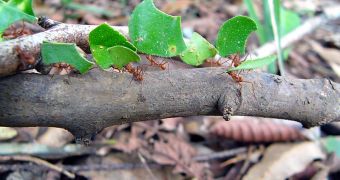One of the most interesting shows offered by nature in tropical South America is represented by the leaf-cutter ants (Atta). A sole colony can leave a tree leafless in just one night. But these ants are real farmers, which do not eat the leaves, but use them for making compost for cultivating fungi in their underground colonies.
A new research made at the Smithsonian's National Museum of Natural History and published in the journal "Proceedings of the National Academy of Sciences" explains how the farming skills of ants evolved. DNA analysis enabled the researchers to build an "evolutionary tree" of fungus-farming ants, showing that all of them evolved from the same ancestor that discovered agriculture about 50 Ma ago. 25 Ma ago, the group started to split in four different specialized agricultural systems.
"We only know of four animal groups that have discovered agriculture: ants, termites, bark beetles and humans. By studying certain fungus-growing ants, which our study indicates are almost like 'living fossils,' we might be able to better understand steps involved in the evolution of ant agriculture," said co-author Ted Schultz, an entomologist at Smithsonian's.
The 15-year study was made on 91 ant species, 65 being fungus-farming species from all four groups. The DNA comparisons were completed with the data delivered by amber fossilized fungus-farming ants coming from the Dominican Republic.
The 50-Ma-old ancestor discovered fungus farming during a time of global warming. In the last 25 Ma, the four different specialized lineages started to cultivate their own unique types of fungi.
About 20 Ma ago, one lineage started to practice "higher agriculture": fungi were cultivated for highly nutritious "fruits", the only part harvested and consumed by the ants. Leaf-cutter ants represent an offshoot of this group, having appeared less than 10 Ma ago.
Some fungus-farming ant species living in South America were proven to be evolutionary "missing links", real living fossils.

 14 DAY TRIAL //
14 DAY TRIAL //